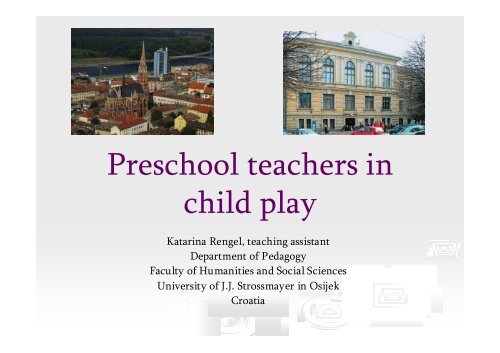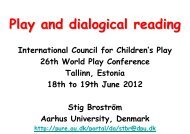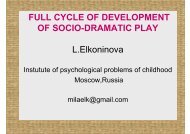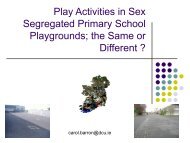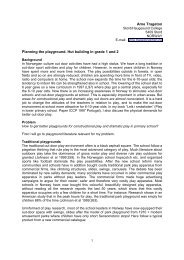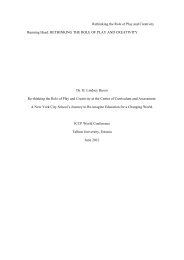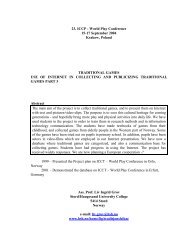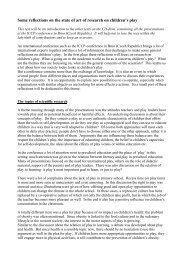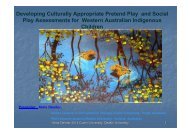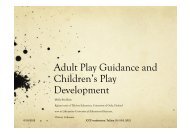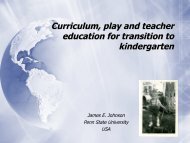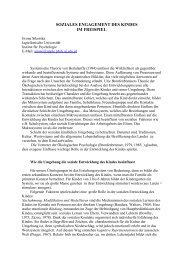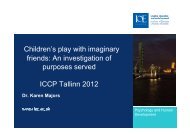Katarina Rengel
Katarina Rengel
Katarina Rengel
You also want an ePaper? Increase the reach of your titles
YUMPU automatically turns print PDFs into web optimized ePapers that Google loves.
Preschool teachers in<br />
child play<br />
<strong>Katarina</strong> <strong>Rengel</strong>, teaching assistant<br />
Department of Pedagogy<br />
Faculty of Humanities and Social Sciences<br />
University of J.J. Strossmayer in Osijek<br />
Croatia
Aim of the paper<br />
The aim of this paper was to review recent<br />
theoretical and empirical literature on the<br />
roles of preschool teachers in child play<br />
More specifically, the aim was to determine<br />
dominant understandings of the roles of<br />
preschool teachers in child play
Play as an educational tool<br />
Dominant discourses of preschool teachers<br />
roles’ in child play<br />
Opponents of preschool teachers’ involvement<br />
in play<br />
Building bridges between the perspectives of<br />
adults and children’s s perspectives
Play as an educational tool<br />
In the reviewed literature, play is defined as an<br />
intrinsically motivated, expressive, transformational,<br />
process-oriented, oriented, free, independent activity.<br />
?<br />
On the other hand, in literature about play, ”learning<br />
through play” is a commonly found phrase.
The separation of play<br />
and learning is<br />
artificial and does not<br />
exist in free play<br />
(Babić, Irović, , 2004).<br />
Play and learning<br />
are interwoven.<br />
learning derives from<br />
the nature of play<br />
Play is a critical scaffold<br />
that enables children<br />
to advance to higher<br />
ability levels in<br />
all developing areas<br />
(Isenberg,<br />
Jalongo, , 1997).<br />
learning tool placed<br />
in the context of play
What is a preschool teacher in child play?<br />
What is the purpose of preschool teachers’ involvement?<br />
Roles/ways and levels of involvement?<br />
If we are considering roles of preschool teachers in child<br />
play, whose perspective is our starting point i.e. whose<br />
perspective are we advocating:<br />
• perspective of adults<br />
• children’s perspective<br />
• perspective of adults and children’s perspective?<br />
What are roles of preschool teachers in child play from<br />
the perspective of adults and what from the children’s<br />
perspective?
Dominant discourses of preschool<br />
teachers roles’ in child play<br />
Preschool teachers’ involvement in child play<br />
is advocated from the perspective of adults:<br />
Best practice mandates teachers’ involvement<br />
in play (with respective roles on different<br />
levels) so that it can have a maximum impact<br />
on children’s learning and development.
One of the justifications for preschool teachers’<br />
involvement in child play:<br />
Preschool teachers’ involvement in child play<br />
is related to learning, development and taking<br />
responsibility for own learning i.e.<br />
development meta-learning skills.
Or specifically, Johnson et al. (1999) suggest<br />
other advantages of teachers’ involvement in<br />
play:<br />
• letting children know play is valuable<br />
• attachment to the adults playing with them<br />
• increased attention span<br />
• increased peer interaction<br />
• longer and more elaborate play episodes<br />
In the reviewed literature, the issue was not so<br />
much if preschool teachers should be involved<br />
in child play, but how they should be involved<br />
in child play.
Two types of preschool teachers’<br />
involvement<br />
The two extremes can empower each other or go<br />
further apart, separating from children’s deeply<br />
rooted way of learning and becoming didactic<br />
(Miller, Almon, 2009).
Guidance of play (1)<br />
Preschool teachers dominating play and employing<br />
inappropriate interventions:<br />
• being too demanding<br />
• directing play<br />
• excessively interfering<br />
• not knowing how to<br />
pretend<br />
• over-structuring play<br />
• reducing children’s<br />
opportunities for<br />
discovery, critical<br />
thinking, peer interaction<br />
etc.<br />
• interrupting play to teach<br />
academic skills and<br />
knowledge<br />
• always playing the way<br />
with the same material<br />
• redirecting children’s<br />
behaviour: direct<br />
suggestions, veiled ‘orders’,<br />
direct physical involvement<br />
(e.g. physical relocation)
Guidance of play (2)<br />
Guided, directed play does not require the<br />
same level of skills, initiative and decision-<br />
making, and therefore does not offer the<br />
same learning experience. It results in:<br />
• less constructive play<br />
• more non-play time<br />
• repetitive pretend behaviour<br />
• negatively affecting the social dimension of play<br />
…
Support of play (1)<br />
Preschool teachers with an active and subtle presence,<br />
minimally intervening, supporting the planning of<br />
play and unobtrusively building on children’s<br />
interests.<br />
Bodrova, Leong (2006) distinguish between direct<br />
(modelling<br />
ways of playing with a toy, taking turns,<br />
settling disputes, verbalizing what is happening…)<br />
and indirect (observing, setting the environment,<br />
choosing materials, encouraging children, providing<br />
experiences that inspire children…) ) roles preschool<br />
teachers take, which support play.
Support of play (2)<br />
The specific role of preschool teachers depends<br />
on the age and play stage of the child, but<br />
also on the abilities of other children.<br />
Indicators of preschool teachers’ involvement<br />
that supports play could be children’s<br />
competency and participation in play.
Opponents of preschool teachers’<br />
involvement in play<br />
Opponents claim that preschool teachers’<br />
involvement can disrupt and overpower<br />
children’s s play activities resulting in reduced<br />
learning and discovery opportunities.<br />
Smith (2010) claims play can be used by adults<br />
to manipulate children in the interests of<br />
adults (e.g. to keep children out of way or<br />
encourage them to play with sophisticated<br />
toys).
Guidance, support or non-involvement:<br />
empirical evidence (1)<br />
Research suggest that in ECE reality preschool<br />
teachers do not get sufficiently involved in<br />
child play or are involved in a way that guides<br />
and corrects play.
Guidance, support or non-involvement:<br />
Possible reasons:<br />
empirical evidence (2)<br />
• pressure for academic readiness<br />
• outcomes of learning through play are not as<br />
transparent as outcomes of direct instruction<br />
• organizational, program burdens i.e. overscheduling<br />
• preschool teachers not being able to follow the logic<br />
of child play<br />
• preschool teacher’s implicit/personal theory about<br />
play
To conclude…<br />
Despite advocacy of the supporting role of preschool<br />
teachers in child play, empirical research suggests that<br />
guidance or non-involvement of preschool teachers in<br />
play are more prominent in ECE reality.<br />
In the reviewed literature, preschool teacher’s<br />
involvement and roles in child play are<br />
considered from the perspective of adults (in<br />
terms of e.g. learning outcomes, developmental<br />
benefits…).
Children’s perspective<br />
• There have been attempts to “capture” the children’s<br />
perspective in ECE research (Sandberg, Pramling-Samuelsson,<br />
2005; Einarsdottir, 2005; Kernan, 2007; Stamatoglou, 2004…),<br />
emphasizing the significance of the perspectives of all the<br />
stakeholders in the ECE reality.<br />
• The results of these research suggest that:<br />
• children describe preschool teachers as those who prefer calm and quiet<br />
play; those who organize, control and teach<br />
• children value being able to choose what to do, playing with their peers,<br />
free time, spontaneity, freedom<br />
• children’s ideas about preschool teachers contribution to play are: help<br />
during conflicts, help when children cannot find a play-mate, for safety<br />
• children’s view of the way preschool teachers “should” get involved is<br />
by assuming certain roles or by offering suggestions
Building bridges between the perspectives<br />
of adults and children’s s perspectives<br />
The social-cultural context of children’s lives calls for<br />
a balance between the perspective of adults and<br />
children’s perspective.<br />
In the reviewed literature, the elaborated benefits of<br />
play come from the perspective of adults and<br />
therefore raise the question concerning the<br />
benefits of play from the children’s s perspective,<br />
which needs to be brought to consciousness in<br />
preschool teachers’ personal theories.


